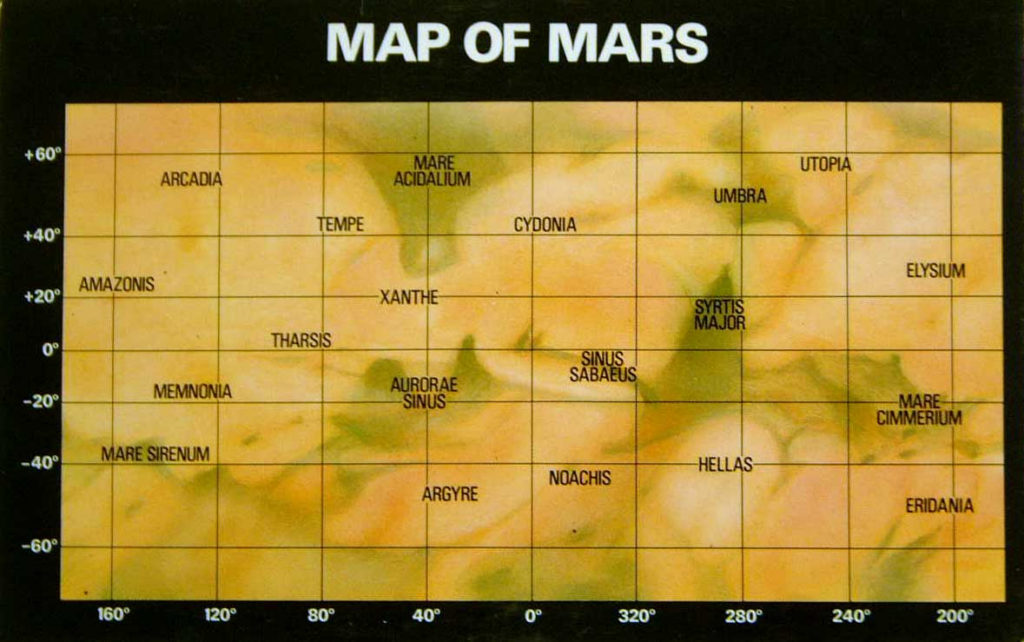Sky Report: November 28 – December 4

I made this map of Mars from my backyard observatory in early 1965. No spacecraft had yet visited Mars to reveal the planet’s true nature, and this map followed the classic style.
Every 26 months the earth catches and passes Mars, which being more distant from the sun moves slower in its orbit. On the 30th we’re as close to Mars as we will come this time around, and then Mars is 50 million miles distant. Mars has been getting brighter and rising earlier, and now it’s visible all night long. It’s the third brightest thing in the night sky, after the moon and Jupiter. Mars is in Taurus, north of Orion, centered in the part of the sky with the most bright stars. Its yellow-orange color helps identify it.
Mars lies precisely opposite the sun on December 8th when it rises at sunset and sets at sunrise, but in practice it does this now. Look for it low in the northeast as the sky grows dark, nearly overhead at about 1 a.m., and very low in the northwest as morning twilight begins.
Each time we pass Mars we don’t come equally close to it. Our earth’s orbit is out of round by 3% but Mars’ orbit is out of round by 9%. This month it is 50,612,000 miles from earth – which is not especially close. At closest, Mars can be 34,621,000 miles distant, as in 2003; its most distant when closest is 63,017,000 miles as in 2027.
Mars is twice the actual diameter of our moon (roughly 4,000 vs. 2,000 miles) but 200 times more distant, so it appears tiny through a telescope. The diameter of our moon is 1800” (arcseconds) vs 17” for Mars, so it’s disappointingly small, having the apparent size of a small lunar crater. Even when it is closer, as in 2003, its diameter is only 25”. It takes an uncommonly good telescope to see markings on its surface. Unfortunately there is (yet) no public observatory in southern Utah where you can go to see Mars for yourself.
Two other planets are out tonight. The brightest is Jupiter, which is twice as bright as Mars. Jupiter sits half-way up the southern sky at the end of evening twilight, which is the best time to look at it through a telescope, and it sets soon after midnight. The bright gibbous moon is less than 3° below Jupiter on the evening of the 1st in a beautiful pairing of the two brightest objects in the night sky; you can easily see both together in binoculars. Jupiter is 1800 times as distant as the moon.
And Saturn is still there too, although not for long. It (and all the planets) sets one-half hour earlier each week and we’ll lose it soon after the New Year. Look for it one-third of the way up the southwest sky as twilight ends, 40° from Jupiter, and it sets two hours before Jupiter does. The crescent moon is 6° below Saturn on the evening of the 28th and they will fit together in the field of view of most binoculars. Saturn is 4130 times as distant as the moon.
Stellar Vista Observatory provides portable telescopes and tripod mounted binocular kits on loan for free to residents and visitors in Kane County. Enhance your enjoyment of the night sky! For details or to request a loan, visit https://stellarvistaobservatory.org/discover-the-night-sky/ or drop in to the Kane County Office of Tourism.
The Sky Report is presented as a public service by the Stellar Vista Observatory, a nonprofit organization based in Kanab, Utah, which provides opportunities for people to observe, appreciate, and comprehend our starry night sky. Additional information is at www.stellarvistaobservatory.org. Send questions and comments to John@StargazingAdventures.org.






Comments are closed.